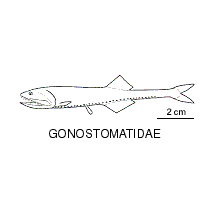- Classification
- ACTINOPTERYGII
- STOMIIFORMES
- GONOSTOMATIDAE
-
Fish Classification
-
Class
ACTINOPTERYGII Ray-finned fishes -
Order
STOMIIFORMES Dragonfishes -
Family
GONOSTOMATIDAE Bristlemouths
Family GONOSTOMATIDAE
Small, deep-sea bioluminescent fishes with elongate compressed bodies and ventral rows of light organs.
Bristlemouths are deepwater, oceanic fishes and members of the genus Cyclothone are some of the most abundant vertebrate animals on Earth.
More Info
|
Family Taxonomy |
Worldwide family with 8 genera and more than 25 species, all genera and 18 species known from Australian waters. |
|
Family Distribution |
Worldwide in all oceans; epi-, meso- and bathypelagic, usually in 300-3000 m. |
|
Family Description |
Body moderately elongate, compressed; mouth large, reaching well beyond eye; jaw teeth in rows; gill rakers well-developed, pseudobranchiae usually absent, chin barbel absent. One or more longitudinal rows of photophores on ventral surface of body, photophores present or absent on isthmus, posterior orbital photophore absent. Bony pectoral radials 4 in most, one in Cyclothone. Dorsal fin small, origin usually at or slightly posterior to middle of body in most, anal-fin base long, pectoral and ventral fins small; adipose fin present or absent. Scales, when present, cycloid, weakly attached. |
|
Family Size |
Small fishes, from 2 cm to about 36 cm, usually less than 20 cm; some very small species are delicate inhabitants of the plankton. |
|
Family Feeding |
Carnivores - known to feed on small fishes and crustaceans. Species of small genera such as Cyclothone, feed mostly on small pelagic crustaceans such as copepods. Larger species feed on larger crustaceans and small fishes. Some species also feed on salps and small jellyfishes. |
|
Family Reproduction |
Many species are sexually dimorphic and/or hermaphroditic. Little is known of eggs or larvae, as species identities are poorly known and larvae are easily confused with those of phosichthids and sternoptychids. Larval pigmentation and development of photophore patterns are diagnostic; photophores develop in two patterns, either simultaneously ("white" photophore stage) or gradual and protracted. Larvae at hatching - body long, slender, gut not trailing, eyes oval, unpigmented, becoming round, mouth unformed, pigment light, usually on midbody, gas bladder and gut. |
|
Family Commercial |
Although most are rarely taken, some are caught as bycatch in deep commercial trawls. Some species are among the most common fishes in the ocean, but are rarely caught due to their small size and very deep waters in which they live. Bristlemouths are food for many other larger fishes that inhabit the oceanic midwaters. |
|
Family Remarks |
The light produced by photophores is from a biochemical reaction occurring within body cells (intrinsic bioluminescence) of the bristlemouths, rather than being produced by luminescent bacteria. |
|
Author |
Dianne J. Bray & Martin F. Gomon |
References
Ahlstrom, E.H., W.J. Richards & S.H. Weitzman. 1984. Families Gonostomatidae, Sternoptychidae, and associated stomiiform groups: development and relationships, pp. 184-198 In Moser H.G., W.J. Richards, D.M. Cohen, M.P. Fahay, A.W. Kendall, Jr. & S.L. Richardson (eds). Ontogeny and Systematics of Fishes. Am. Soc. Ichthyol. Herpetol. Spec. Publ. No. 1. 760 pp.
Harold, A.S. 1998. Phylogenetic relationships of the Gonostomatidae (Teleostei: Stomiiformes). Bull. Mar. Sci. 62(3): 715–41.
Harold, A.S. 1999. Gonostomatidae, Sternoptychidae, Phosichthyidae, Astronesthidae, Stomiidae, Chauliodontidae, Melanostomiidae, Idiacanthidae, and Malacosteidae. In Carpenter, K.E. & V.H. Niem. Species identification guide for fisheries purposes. The living marine resources of the western central Pacific. Batoid fishes, chimeras and bony fishes part 1 (Elopidae to Linophrynidae). FAO, Rome.
Harold, A.S. & M.F. Gomon. 2008. Family Gonostomatidae. In Gomon. M.F., Bray, D.J. & Kuiter, R.H (eds). Fishes of Australia's Southern Coast. Sydney : Reed New Holland 928 pp.
Harold, A.S. & S.H.Weitzman. 1996. Interrelationships of Stomiiform Fishes, pp. 333-353. In Stiassny, M.L.J., L.R. Parenti & G.D. Johnson (eds.) The Interrelationships of Fishes. Academic Press, London.
Miya, M. & T. Nemoto. 1991. Comparative life histories of the meso- and bathypelagic fishes of the genus Cyclothone (Pisces: Gonostomatidae) in Sagama Bay, central Japan. Deep-Sea Res. 38(1): 67-89.
Miya, M. & M. Nishida. 2000. Molecular systematics of the deep-sea fish genus Gonostoma (Stomiiformes: Gonostomatidae): two paraphyletic clades and resurrection of Sigmops. Copeia 2000(2): 378-389.
Richard, W.J. 2006. Ch. 16 Gonostomatidae: Bristlemouths, p. 183, In W.J. Richards (ed). Early Stages Of Atlantic Fishes: An Identification Guide For The Western Central North Atlantic. CRC Press, Taylor and Francis Group, Boca Raton, FL, 2640 pp.
Schaefer, S., R.K. Johnson & J. Babcock. 1986. Family No. 73: Photichthyidae (pp. 243-247), Family No. 74: Gonostomatidae, pp. 247-253 In smith, M.M. & P.C. Heemstra. Smiths' Sea Fishes. J.L.B. Smith Inst. Ichthyol., Grahamstown, South Africa.
Watson, W. 1996. Gonostomatidae: Bristlemouths, p. 247-267. In H.G. Moser (ed.), The early stages of fishes in the California Current region. CalCOFI Atlas 33. Allen Press, Lawrence, KS, 1505 pp.




































